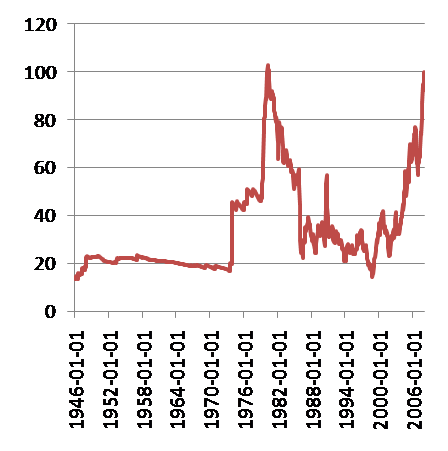Is China Unfairly Blamed for Global Inflation?
Real Time Economics, the economic blog sponsored by wsj has a quite heated debate going on. I find the whole debate interesting: just 2 years ago, economists were still busy trying to find out the empirical evidence to support the notion that China contributed a great deal to the low US/global inflation, now the debate is being changed to 'let's blame China for global inflation'.
Most people see rising domestic inflation in China as evidence (the most recent number reads 7.1%) of such argument, and adding to that are China's fast GDP growth above 10% and 1.3 billion population accessing the limited global resources. So an easy blame and simple logic, right?
To prove a point, economists like to use counterfactuals. Here I give it a try.
First, China's GDP growth has been around 10% since 2003, and on average of 7-8% since early 90s, so why fast growth is blamed for inflation now?
Second, on China's exports of high inflation to the world. China's inflation went back to positive territory in 2003 and has been around 2.5 per cent on average, a very low range. Only until 2007, we saw the first big jump from 2.8% in 2006 to 6.5%. Before 2003, and much of late 90s, China got deflation, that's negative inflation.
How did everything all happen in 2007?
What did not change but just changed recently, especially in 2007, was the Fed's monetary policy, and came along with it was sharp falling US dollar.
It is true that US dollar has been falling since 2002, but weak dollar was most talked about and raised most worries in 2007, when even supermodel Gisele was demanding Euro-pay in her contract. In 2007, commodity prices in nominal dollar terms all shot to the roof: Oil first touched $100 since 1980, gold rose above $900 and expected to pass $1000. When expectations changed, you have to worry. And indeed we had a classic exchange rate overshoot, and all of these are reflected in prices.

Figure 1: Nominal value of the dollar against a broad basket (blue), and against a basket of major currencies (red), in logs, rescaled to 0 in 2002M01. NBER-dated recessions shaded gray. Source: Federal Reserve Board via FRED II, NBER.
(courtesy of Jim Hamilton)
In particular, US dollar is depreciating fast against Chinese Yuan (chart below). When dollar is down against RMB, US import prices naturally rise. After all, what you demand is what you get (see chart below). There is no such a world that you could have a higher RMB but lower import prices.

Figure 2: Price of goods imports from East Asian NICs (red), and price of goods imports from China (blue) in logs, rescaled to 0 in 2004M01. NBER-dated recessions shaded gray. Source: BLS release of 15 February 2008, NBER and author's calculations.
(courtesy of Jim Hamilton)
How about food prices? I admit there are some merits when people argue that soaring Chinese and Indian economy put extra pressure on world food prices. But again, China did not start to grow just recently, but why inflation now?
My guess is that this is much due to Bush's Energy Policy Act in 2005, in which he basically gave a go-order to convert corn to Ethanol, the alternative energy that's supposed to ease oil price. In reality, what we got is the classic example of poorly designed policy with unintended consequences. Corn itself is food, imagine what will happen to food price when you pull out a large chunk of food supply from the world market, and be reminded that corn is also widely used for many other purposes such as feeding cattle. Converting food to energy is just stupid! Shall I remind you that there are still 1 billion people living under $1 per day?
$100 oil, again?
Paul Krugman has a nice chart of oil in Feb. 2008 dollar. We are very close to the historical high. However, with recession mounting (or we're already in it), I don't think the price is sustainable.
Real oil prices in Feb. 2008 dollars:



